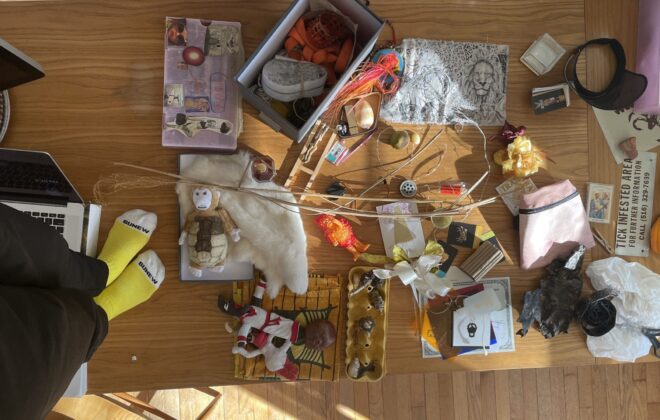Show-a-Thing Reflection
Inspirations and thoughts from the guest feedback sessions:
I am immensely grateful for the opportunity to have received feedback from three guests who all gave a different and insightful perspective on my project. As one of the guests commented, the project involves much public engagement; it is, therefore, imperative to be clear about who the public or the audience is. After I proposed having a small black box space, a guest asked: Why does it have to shape like a box? How does the inner configuration/ spatial layout look like inside the space? As our discussion continued, it seemed like the spatial component is an experiential narrative or an extension of narrative to the literal narrative that space embraces. As for the narrative structure, a guest asked: Are there many narratives or one main narrative? Does the narrative(s) happen simultaneously or separately? These questions led the discussion towards time-based story-telling, which inspires me to try out different ways of playing with the repertoire of interview sources I collect in the future.
Besides the takeaways mentioned above, the feedback sessions had three major highlights, which have been my sources of inspiration. One was that a guest said the idea of having the space coated with a one-way mirror coating. I thought the introduction of the one-way mirror was transformational to space and metaphorically interrogated the idea of public visibility of social topics such as senior citizenship. It is intriguing to have the audience see the world when the world is not able to see them, entering into a state that is analogous to the social life of the “elderly.” I wonder how I could expand on the idea of public visibility and turn it into a smart design as part of the space, similar to the idea of the one-way mirror.
Another exciting thought brought up from the conversations was the idea of senior citizenship viewed not only from the conventional aging perspective, but in the context of the workspace. How does one’s productivity relate to one’s seniority? How do genders and types of vocation/labor play a role in the aging process? The questions appear interesting as Shenzhen embraces a heavy work culture. The work culture, notably, seems to shape the familial space in addition to the personal life. As my interviews indicate that many “migrant parents” move to Shenzhen to babysit their grandchildren as the parents are busy working, work/labor intimately ties to not the aging of an individual, but that of an entire family.
Related Posts
Leave a Reply Cancel reply
You must be logged in to post a comment.
Kat Sullivan
Adam Colestock
Helen (Chenuan) Wu
Christina Lan
Dorian Janezic
George Faya
Julia Myers
Kelsie Smith
Michael Morran
Po-Wen Shih
Liu Siyan
Fisher Yu
—
Craig Protzel
Christopher Wray
Haoqi Xia
Hayden Carey
Katherine Nicoleta Helén
Maria Maciak
Parisa Shemshaki
Sakar Pudasaini
Skyler Pierce
Steven Doughty
Yiqi Wang
—
Andrew Lazarow
Benoit Belsot
Enrique García Alcalá
Hongyi Zhang
Jay Mollica
Li Shu
Teddy (Jian) Guo
Monika Lin
Wenye Xie
Yiru Lu

